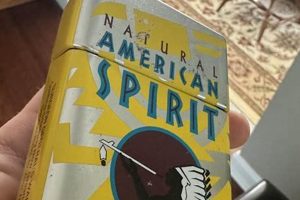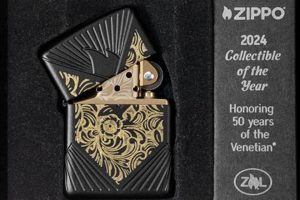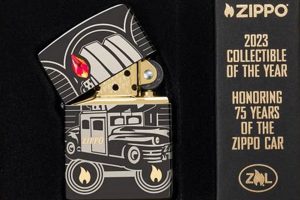Problems related to accumulating and maintaining Zippo lighters can encompass a wide range of challenges. These can include difficulties in authentication, restoration, storage, or even the emotional and financial aspects of managing a substantial collection. For example, a collector might struggle to verify the authenticity of a rare model, find replacement parts for a damaged lighter, prevent tarnishing in long-term storage, or decide on the best approach to insuring valuable pieces.
Addressing these challenges is essential for preserving the historical and monetary value of a collection. Understanding the nuances of Zippo manufacturing, identifying counterfeit markers, and employing appropriate cleaning and storage methods are crucial skills. The historical context of these lighters, spanning decades of design evolution and social influence, adds another layer of complexity and significance to collection maintenance. Proper care ensures that these iconic pieces remain functional and retain their value over time.
This article delves further into specific challenges related to Zippo lighter collections. Topics to be covered include authentication techniques, effective restoration strategies, best practices for storage, and navigating the market for buying, selling, and insuring these collectible items.
Tips for Managing a Zippo Lighter Collection
The following offers practical guidance for addressing common challenges encountered when building and maintaining a Zippo collection.
Tip 1: Authentication is Paramount: Scrutinize potential acquisitions carefully. Reference reputable online resources and printed guides to understand specific model variations, markings, and production dates. Consulting with experienced collectors or appraisers can provide valuable insights.
Tip 2: Invest in Proper Storage: Specialized cases or drawers lined with acid-free materials protect lighters from scratches, tarnish, and dust accumulation. Maintaining a stable temperature and humidity level is also crucial for long-term preservation.
Tip 3: Handle with Care: Avoid dropping or roughly handling lighters. Use appropriate tools for repairs or adjustments to minimize the risk of further damage. Fingerprints can accelerate tarnishing, so handle lighters with clean hands or cotton gloves.
Tip 4: Understand Repair and Restoration: Learn to perform basic maintenance tasks like replacing flints and wicks. For more complex repairs, consult a qualified Zippo repair specialist to maintain the lighter’s originality and value.
Tip 5: Document Everything: Maintain a detailed inventory, including photographs, purchase dates, prices, and any known historical information about each lighter. This documentation is essential for insurance purposes and managing the collection effectively.
Tip 6: Research Market Values: Regularly monitor online auction sites, collector forums, and price guides to stay informed about the current market value of similar lighters. This knowledge is crucial for both buying and selling.
Tip 7: Insure Valuable Pieces: High-value lighters should be insured under a specialized collectibles policy. Consult with an insurance broker experienced in insuring collectibles to ensure adequate coverage.
By following these practices, collectors can protect their investment, preserve the historical significance of their Zippo lighters, and enjoy the rewards of a well-maintained collection.
In conclusion, these strategies offer a comprehensive approach to overcoming the complexities of Zippo lighter collection management.
1. Authentication
Authentication plays a critical role in addressing potential problems within a Zippo lighter collection. Establishing a lighter’s genuine status directly impacts its value, insurability, and historical significance. Without proper authentication, a collection may contain counterfeit or misrepresented items, leading to financial losses and historical inaccuracies. For example, a lighter advertised as a rare wartime model, if proven inauthentic, loses significant value and compromises the collection’s integrity. The process often involves verifying date codes, examining construction details, and comparing markings against established reference materials. Overlooking this crucial step can undermine the collector’s efforts and lead to significant complications.
Further emphasizing the importance of authentication is its connection to potential restoration efforts. Restoring a counterfeit lighter, while potentially improving its appearance, does not increase its inherent value. In some cases, improper restoration techniques can even decrease the value of a genuine Zippo. Therefore, authentication should precede any restoration work to ensure resources are invested wisely and the historical integrity of genuine pieces is preserved. A knowledgeable collector might utilize online forums, consult expert authenticators, or reference comprehensive guides to confirm a lighter’s provenance before undertaking restoration. This proactive approach minimizes the risk of wasted effort and financial loss.
In summary, authentication serves as a cornerstone of responsible Zippo collecting. It protects against financial risks associated with counterfeit items, guides restoration decisions, and ensures the collection’s historical accuracy. Diligent authentication practices are essential for maintaining a collection’s value and preserving the legacy of these iconic lighters.
2. Storage
Storage plays a crucial role in mitigating potential problems within a Zippo lighter collection. Inadequate storage can lead to a range of issues, impacting both the aesthetic and functional integrity of the lighters. Exposure to humidity can cause tarnishing and corrosion, affecting the finish and potentially the mechanism. Dust accumulation can clog the lighter’s workings, leading to malfunctions. Furthermore, improper handling during storage, such as stacking lighters without adequate protection, can result in scratches and dents. For example, a rare chrome Zippo stored in a humid environment without proper protection might develop surface rust, significantly diminishing its value. Conversely, a well-maintained lighter stored in a controlled environment, utilizing protective cases and desiccants, retains its pristine condition and value over time. The impact of storage practices therefore directly influences the long-term viability and value of a collection.
The choice of storage materials also significantly impacts the condition of a Zippo collection. Storing lighters in materials that off-gas volatile organic compounds (VOCs) can damage the finish or cause discoloration. Similarly, acidic environments, like those created by certain types of wood or cardboard, can accelerate corrosion. Collectors should opt for archival-quality storage materials, such as acid-free boxes or trays, to prevent these issues. Using specialized Zippo display cases with airtight seals and compartments further enhances protection against environmental factors and accidental damage. These preventative measures contribute significantly to preserving the condition and value of the collection over time.
In summary, appropriate storage is fundamental to preserving a Zippo collection. Choosing suitable storage materials and maintaining a controlled environment minimizes the risk of damage from humidity, dust, and physical contact. This proactive approach safeguards the collection’s value and ensures the lighters remain functional and aesthetically pleasing for years to come. Neglecting proper storage can lead to costly restoration efforts or irreversible damage, underscoring the crucial role of preventative storage practices in responsible Zippo collecting.
3. Maintenance
Maintenance is crucial for mitigating potential problems within a Zippo lighter collection. Neglecting regular upkeep can lead to a decline in functionality, aesthetic appeal, and overall value. Consistent maintenance ensures the lighters remain operational and preserves their collectible status. Without proper care, mechanisms can seize, finishes can deteriorate, and the historical significance of the items can diminish due to neglect.
- Flint Replacement:
Regular flint replacement is essential for consistent sparking and reliable functionality. A worn flint can cause misfires and frustration. Using the correct replacement flint and employing the proper technique ensures the lighter operates as intended. Failing to replace flints can lead to unnecessary wear on the sparking wheel and potentially damage the lighter’s internal components. For example, using an incorrect flint type can damage the spark wheel or create excessive wear, necessitating costly repairs. Conversely, consistent flint replacement minimizes wear, extends the lighter’s lifespan, and maintains its operational reliability.
- Wick Maintenance:
The wick plays a vital role in fuel delivery and consistent burning. Regular trimming and replacement prevents clogging, ensures an even flame, and prevents sooting. A neglected wick can cause an uneven burn, reduced fuel efficiency, and an unpleasant odor. Trimming the wick regularly using proper tools, such as Zippo wick scissors, prevents these issues. For example, allowing the wick to become excessively charred restricts fuel flow and impacts the lighter’s performance. Replacing a worn wick maintains optimal functionality and prevents further complications.
- Fuel Management:
Proper fuel management involves using the correct type of Zippo lighter fluid and avoiding overfilling. Overfilling can lead to leaks, fuel evaporation, and potential fire hazards. Using inferior quality fuel can clog the wick and damage internal components. Regularly checking for and addressing leaks promptly prevents damage to the lighter’s finish and ensures safe operation. For example, using gasoline or other inappropriate fuels can severely damage the lighter’s internal components and create a safety hazard. Adhering to recommended fuel types and filling procedures ensures optimal performance and longevity.
- Cleaning and Polishing:
Regular cleaning and polishing maintains the aesthetic appeal of the collection. Removing fingerprints, dirt, and grime prevents tarnishing and corrosion. Using appropriate cleaning agents and techniques safeguards the lighter’s finish. For example, using abrasive cleaners can scratch or damage delicate finishes. Employing specialized Zippo cleaning products and soft cloths preserves the lighter’s exterior and maintains its collectible condition. Regular cleaning also facilitates early detection of potential issues like developing corrosion, allowing for timely intervention and preventing further damage.
These maintenance practices are interconnected and contribute to the overall preservation of a Zippo collection. Neglecting one aspect can negatively impact others, creating a cascade of issues. For example, neglecting wick maintenance can lead to excessive fuel consumption and potentially damage the internal mechanism. Regular and thorough maintenance, encompassing each of these facets, protects the investment, ensures the lighters remain functional, and preserves their historical and collectible value. A well-maintained collection stands as a testament to the collector’s dedication and ensures these iconic lighters remain functional and aesthetically pleasing for generations to come.
4. Restoration
Restoration addresses problems arising within a Zippo lighter collection due to damage, wear, or improper previous repairs. It plays a vital role in preserving the functionality, aesthetic appeal, and historical integrity of these collectible items. A well-executed restoration can significantly enhance a lighter’s value and ensure its continued enjoyment for future generations. Conversely, improper restoration techniques can diminish value and compromise historical accuracy. Understanding the nuances of Zippo restoration is therefore crucial for collectors seeking to preserve their investment and maintain the integrity of their collection.
- Case Repair and Refinishing:
The case, a Zippo lighter’s most visible component, is susceptible to dents, scratches, and finish wear. Restoration addresses these issues through dent removal, surface refinishing, and reapplication of original finishes. For instance, a lighter with a deep scratch compromising the chrome plating might undergo a professional refinishing process to restore its original appearance. This process often involves stripping the old finish, repairing any underlying damage, and reapplying a new chrome layer. Careful execution is crucial as improper techniques, like aggressive polishing, can permanently damage the case and diminish the lighter’s value. Correcting previous improper repairs, such as mismatched replacement parts or incorrect finish applications, also falls under this facet of restoration, ensuring the lighter’s authenticity and value are preserved.
- Internal Mechanism Repair:
The internal mechanism, responsible for the lighter’s functionality, can suffer from wear, damage, or improper lubrication. Restoration involves disassembling the lighter, cleaning and inspecting components, replacing worn parts, and ensuring proper lubrication. For example, a lighter with a malfunctioning flint wheel might require replacement of the wheel or adjustment of the spring mechanism. Similarly, a clogged fuel line might necessitate cleaning or replacement. Expert knowledge of Zippo construction and access to authentic replacement parts are crucial for effective internal mechanism repair. Improper repairs, such as using incorrect parts or forcing components, can lead to further damage and compromise the lighter’s functionality.
- Hinge and Lid Replacement:
The hinge, connecting the lid and body, is a critical component subject to wear and damage. Restoration may involve hinge repair, replacement, or reinforcement to ensure proper lid alignment and closure. A loose or broken hinge can render the lighter unusable and detract from its aesthetic appeal. Replacing a damaged hinge with an authentic Zippo part preserves the lighter’s originality and value. Similarly, a bent or damaged lid might necessitate repair or replacement. Proper fitting and alignment are crucial to maintaining the lighter’s smooth operation and iconic “click” sound. These interventions restore functionality and enhance the overall user experience.
- Insert Replacement and Repair:
The insert, containing the fuel chamber, wick, and flint assembly, is another crucial component susceptible to wear and damage. Restoration addresses issues like a damaged flint wheel, clogged fuel line, or worn wick. Replacing a damaged or malfunctioning insert with an authentic Zippo insert ensures proper function and maintains the lighter’s value. Attempting to repair a severely damaged insert can be challenging and might not yield satisfactory results. In such cases, replacing the entire insert with a correct period-specific part is often the most viable solution to restore the lighter to its original working condition.
These facets of restoration are interconnected and contribute significantly to addressing “my Zippo collection issues.” A lighter might require attention in multiple areas, necessitating a holistic approach to restoration. For example, a lighter with a dented case and a malfunctioning flint wheel would require both case repair and internal mechanism work. Understanding these interrelationships is vital for effective restoration planning and execution. By addressing each issue correctly, collectors can preserve their lighters’ functionality, aesthetic appeal, and historical significance, ultimately enhancing the value and enjoyment of their collection.
5. Insurance
Insurance plays a critical role in mitigating financial risks associated with Zippo lighter collections. These collections, often comprising rare or historically significant pieces, represent a substantial investment that requires adequate protection against potential loss or damage. Several factors contribute to the necessity of insurance. Theft, fire, or natural disasters can lead to significant financial losses if a collection is uninsured. Even seemingly minor incidents, such as accidental damage during handling or storage, can result in costly repairs or diminish a lighter’s value. For instance, a limited-edition Zippo commemorating a historical event, if damaged in a fire, could represent a substantial financial loss, not easily recouped without insurance coverage. Similarly, theft of a rare sterling silver Zippo from a collection represents a significant loss, potentially irreplaceable due to its unique historical or sentimental value. Insurance provides a safety net, enabling collectors to recover financially from such unforeseen events.
Obtaining appropriate insurance coverage for a Zippo collection requires careful consideration. Standard homeowner’s or renter’s insurance policies may not adequately cover collectibles, often requiring specialized riders or separate policies specifically designed for valuable items. These specialized policies typically consider factors like a lighter’s appraised value, rarity, historical significance, and provenance. Detailed documentation, including photographs, appraisals, and purchase receipts, is essential for securing adequate coverage and facilitating the claims process in the event of loss or damage. For example, a collector possessing a first-release Zippo from a specific year should obtain a professional appraisal documenting its authenticity and value to ensure sufficient insurance coverage. Working with an insurance broker specializing in collectibles can help collectors navigate the complexities of insuring valuable items and tailor coverage to their specific needs. This proactive approach ensures appropriate protection and facilitates a smoother claims process should the need arise.
In conclusion, insurance is an essential aspect of responsible Zippo lighter collection management. It safeguards against financial losses arising from unforeseen events, protecting the collector’s investment. Securing appropriate coverage requires careful consideration of the collection’s value, rarity, and specific risks. Detailed documentation and consultation with a specialized insurance broker are crucial for ensuring adequate protection and peace of mind. Neglecting insurance can expose collectors to significant financial vulnerability, jeopardizing the long-term viability and enjoyment of their collections.
6. Market Value
Market value represents a critical factor influencing challenges related to Zippo lighter collections. Understanding how market forces impact a collection is essential for making informed decisions regarding acquisition, restoration, and potential sale of these items. Fluctuations in market value can significantly affect a collection’s overall worth, influencing insurance needs and long-term investment strategies. Ignoring market trends can lead to financial losses or missed opportunities. This section explores key facets influencing the market value of Zippo lighters and their implications for collectors.
- Rarity and Condition
Rarity and condition are primary determinants of market value. Limited production runs, special editions, or lighters commemorating specific events often command higher prices due to scarcity. Similarly, lighters in pristine condition, with original finishes and minimal wear, are more desirable to collectors and achieve higher valuations. A rare, mint-condition Zippo from a historically significant period, like World War II, can be exceptionally valuable. Conversely, a common model with significant wear and tear will have a much lower market value. Understanding this interplay helps collectors prioritize acquisitions and restoration efforts.
- Authenticity and Provenance
Authenticity is paramount in the Zippo collecting world. Counterfeit lighters, while potentially visually appealing, hold little to no value. Establishing provenance, the history of ownership and authenticity verification, significantly enhances a lighter’s market value. A lighter with documented ownership history tracing back to a notable figure or event can command a premium. Conversely, a lighter with questionable authenticity, even if visually similar to a valuable model, will struggle to find a buyer in the discerning collector’s market. Therefore, diligent research and authentication are crucial for establishing a collection’s true market value.
- Demand and Trends
Market value is subject to fluctuations driven by collector demand and evolving trends. Certain models or themes might experience periods of increased popularity, driving up prices. Similarly, changing collector demographics and preferences can influence what is considered desirable, impacting market valuations. For example, a surge in interest in a specific historical period might increase demand for Zippos from that era, temporarily inflating their market value. Staying informed about market trends allows collectors to anticipate fluctuations and make informed decisions about buying, selling, or holding onto specific pieces within their collection.
- Historical Significance
Historical significance can significantly impact a Zippo lighter’s market value. Lighters associated with significant historical events, figures, or military units often command higher prices due to their historical context. For instance, a Zippo carried by a soldier during a specific wartime campaign can hold significant historical value, exceeding its intrinsic material worth. Similarly, lighters produced to commemorate important historical events or bearing the insignia of significant organizations can also achieve higher valuations. Recognizing the historical context of a lighter adds another dimension to its market appeal and influences its overall worth.
These interconnected factors contribute significantly to the complexities of managing a Zippo lighter collection. A comprehensive understanding of market dynamics allows collectors to navigate the challenges of authentication, restoration, and valuation. Recognizing the interplay between rarity, condition, authenticity, demand, and historical significance enables informed decision-making, maximizing the collection’s potential value and ensuring its long-term preservation. By staying informed about market trends and prioritizing proper care and authentication, collectors can effectively manage their collections and navigate the dynamic landscape of the Zippo lighter market.
Frequently Asked Questions about Zippo Lighter Collection Challenges
This section addresses common concerns and misconceptions regarding the challenges inherent in building and maintaining a Zippo lighter collection. The following questions and answers provide practical insights for collectors of all experience levels.
Question 1: How can one differentiate between a genuine Zippo and a counterfeit?
Authenticating a Zippo lighter involves careful examination of several key features. These include the bottom stamp (date code and location), the insert markings, the hinge construction, and the overall quality of materials and craftsmanship. Consulting reputable online resources, printed guides, or experienced collectors can assist in this process. Counterfeits often exhibit inconsistencies in these areas, such as incorrect date codes, inferior materials, or poorly replicated markings.
Question 2: What are the most effective methods for preventing Zippo lighter tarnishing and corrosion?
Preventing tarnish and corrosion requires proper storage in a controlled environment. Utilizing airtight containers with desiccants helps minimize humidity exposure. Storing lighters away from direct sunlight and extreme temperatures further safeguards against these issues. Regular cleaning with appropriate, non-abrasive materials also helps maintain the finish and prevents the buildup of corrosive elements.
Question 3: What are the recommended steps to take when a Zippo lighter requires repair?
For basic repairs, such as flint or wick replacement, following manufacturer guidelines or consulting online tutorials can suffice. However, for more complex repairs involving the internal mechanism or case restoration, seeking assistance from a qualified Zippo repair specialist is recommended. Attempting complex repairs without proper knowledge and tools can exacerbate the damage and diminish the lighter’s value.
Question 4: How can one determine the approximate market value of a Zippo lighter?
Determining market value involves researching similar lighters sold through reputable auction sites, online marketplaces, and collector forums. Factors such as rarity, condition, authenticity, and historical significance all contribute to a lighter’s value. Consulting price guides and seeking appraisals from experienced collectors or professionals can provide more precise valuations.
Question 5: What type of insurance is recommended for protecting a valuable Zippo collection?
Standard homeowner’s or renter’s insurance policies often provide limited coverage for collectibles. A specialized collectibles insurance policy, tailored to cover valuable items like Zippo lighters, offers more comprehensive protection against loss, theft, or damage. Consulting with an insurance broker specializing in collectibles is crucial for assessing individual needs and securing adequate coverage.
Question 6: What are common mistakes to avoid when building a Zippo lighter collection?
Common pitfalls include neglecting proper authentication, improper storage practices leading to damage, attempting complex repairs without adequate expertise, and failing to document purchases and provenance. Overpaying for lighters without proper research and neglecting to insure valuable pieces also represent avoidable mistakes. A thorough understanding of these potential issues helps mitigate risks and ensures a more rewarding collecting experience.
Addressing these common concerns equips collectors with the knowledge and resources necessary to overcome the unique challenges of building and preserving a Zippo lighter collection effectively. A proactive approach, emphasizing preventative measures and informed decision-making, safeguards the investment and ensures the long-term enjoyment of these iconic pieces.
For further exploration of specific aspects of Zippo collecting, continue to the next section detailing resources and further reading.
Conclusion
Successfully navigating the challenges inherent in Zippo lighter collections requires diligence, knowledge, and a proactive approach. This exploration has highlighted key issues, including authentication, storage, maintenance, restoration, insurance, and market value dynamics. Each aspect plays a crucial role in preserving a collection’s integrity, value, and historical significance. From verifying a lighter’s authenticity to employing appropriate storage methods and understanding market fluctuations, informed decision-making is paramount for long-term success. Proper maintenance and restoration techniques safeguard against damage and preserve functionality, while adequate insurance coverage protects against unforeseen events. Understanding these interconnected elements empowers collectors to address potential problems effectively and build collections of enduring value.
The enduring appeal of Zippo lighters transcends mere functionality; these objects represent a tangible connection to history, craftsmanship, and personal expression. Preserving these collections requires continuous learning, adaptation to evolving market trends, and a commitment to responsible stewardship. The challenges, while significant, offer opportunities for collectors to deepen their knowledge and appreciation for these iconic pieces. By embracing a proactive approach to collection management, enthusiasts can ensure that their Zippo lighters remain functional, historically relevant, and aesthetically captivating for generations to come.







